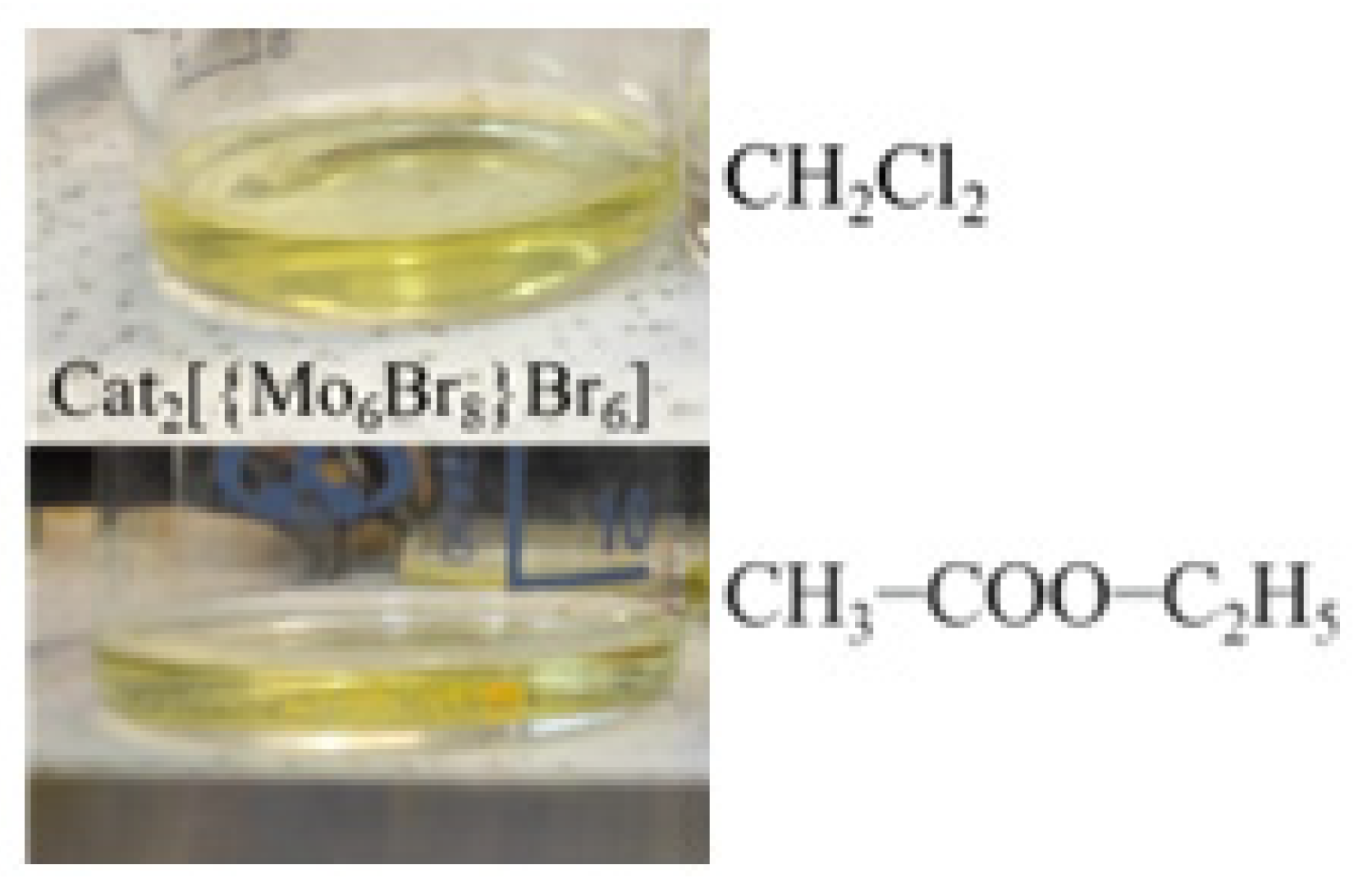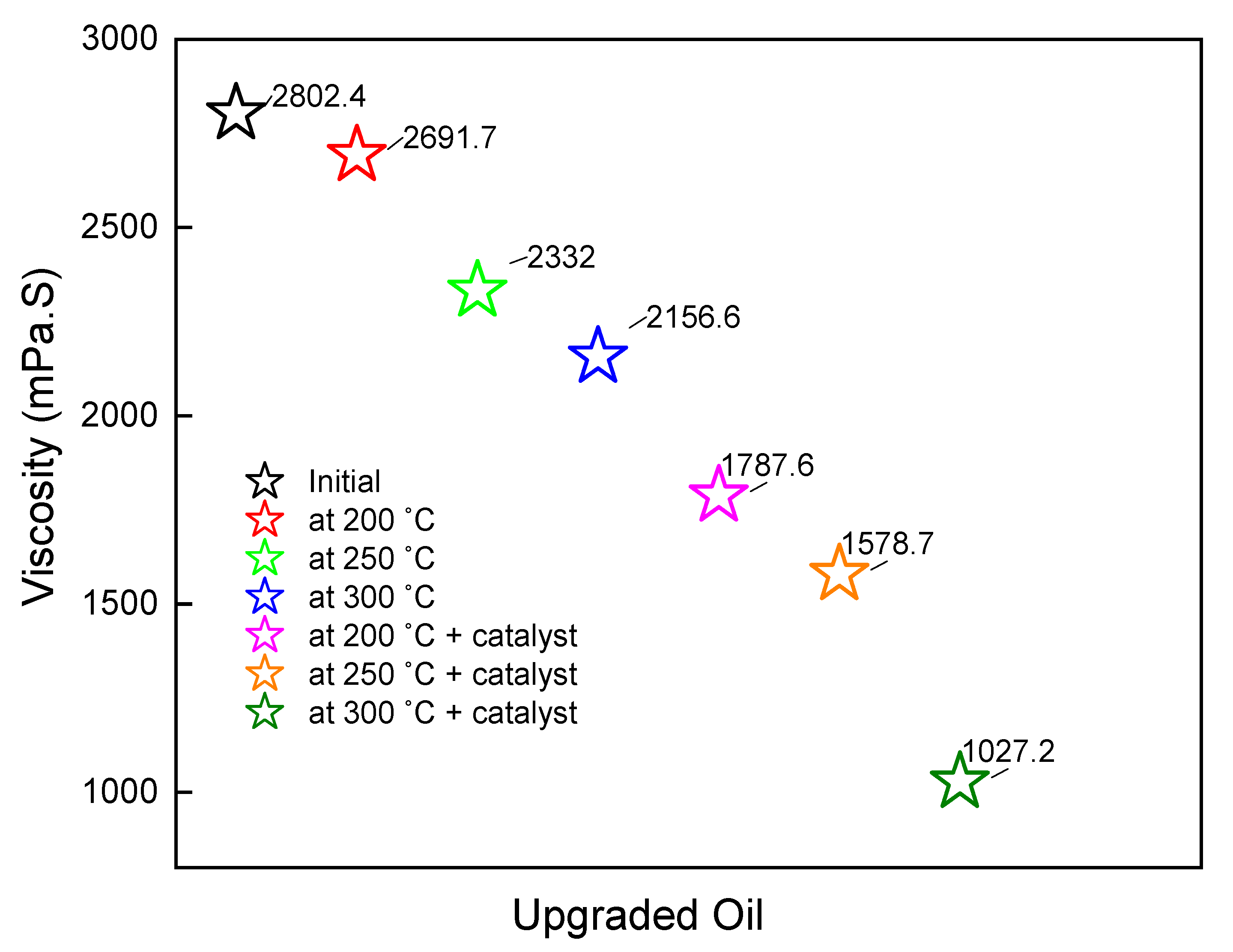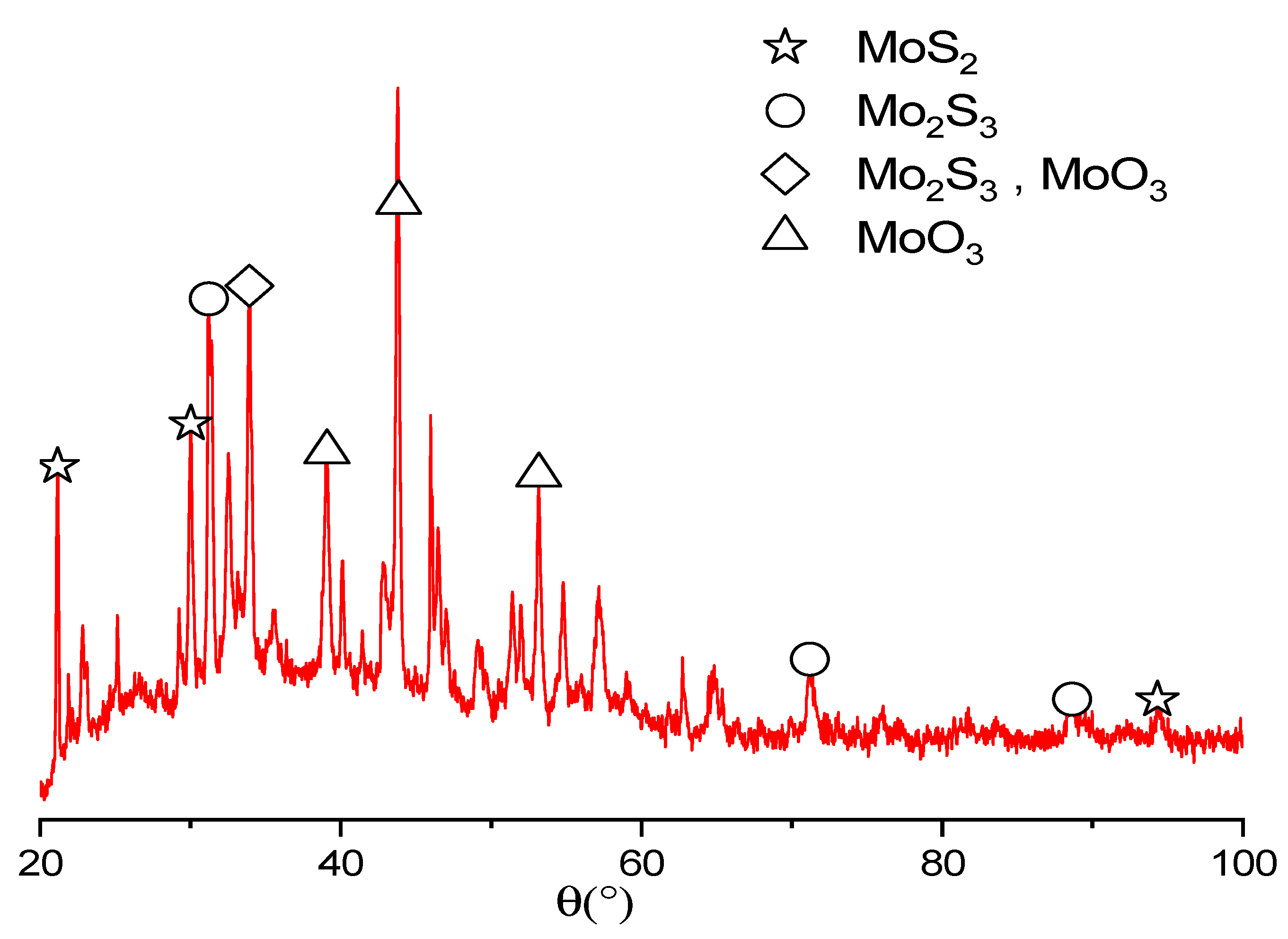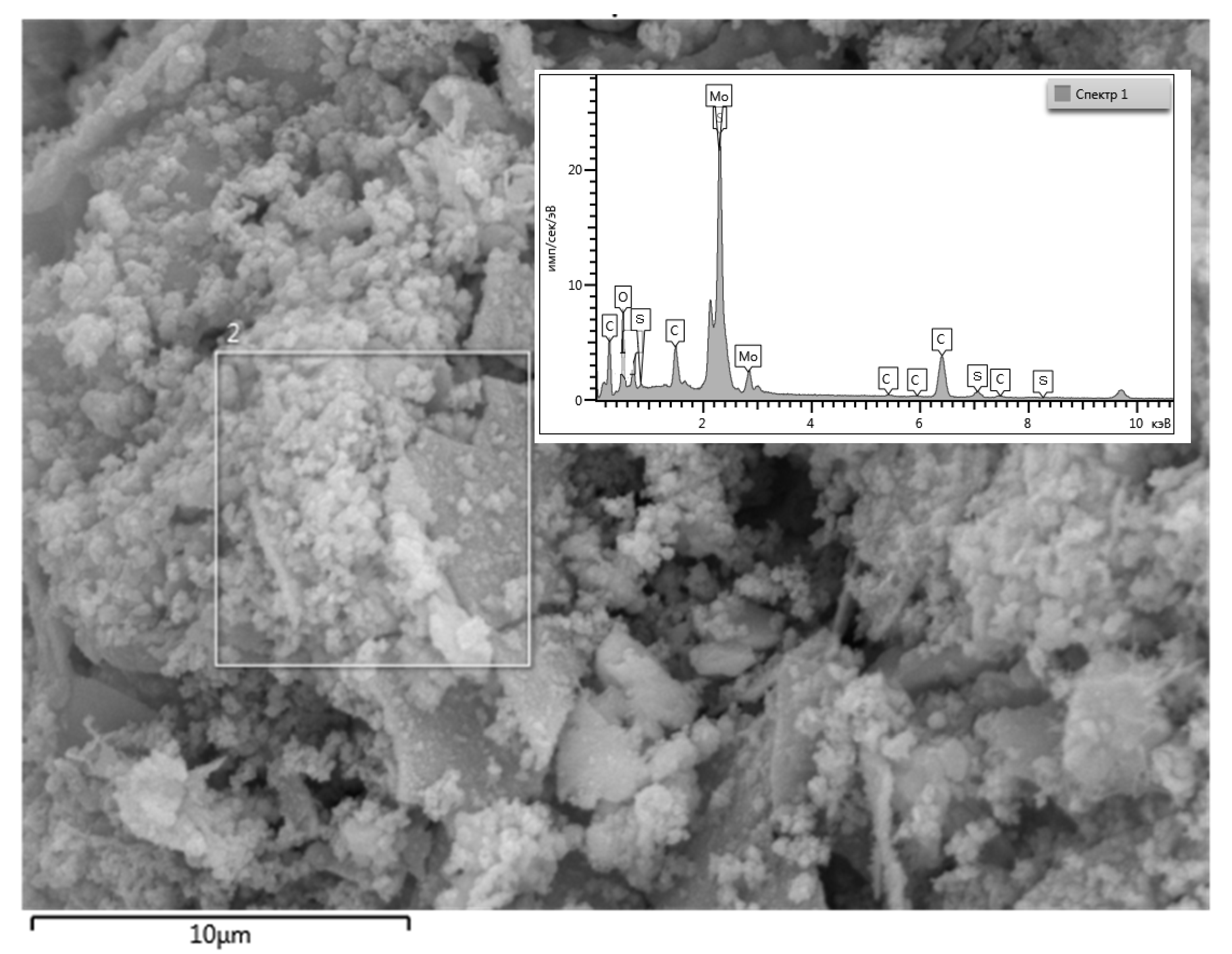Octahedral Cluster Complex of Molybdenum as Oil-Soluble Catalyst for Improving In Situ Upgrading of Heavy Crude Oil: Synthesis and Application
Abstract
:1. Introduction
2. Experimental
2.1. Materials
2.2. Catalyst Synthesis
2.3. Catalysts Characterization
2.3.1. Fourier-Transform Infrared Spectroscopy (FTIR)
2.3.2. X-ray Diffraction Analysis
2.3.3. Scanning Electron Microscopy (SEM)
2.4. Catalyst’s Effect on Aquathermolysis Performance
2.4.1. Heavy Oil Upgrading in the Presence and Absence of Oil Soluble MoOHCs
2.4.2. Gas Chromatography Analysis
2.4.3. Viscosity Measurement and Elemental Analysis
2.4.4. SARA Analysis
3. Results and Discussion
3.1. GC of Evolved Gases
3.2. Viscosity Measurement
3.3. SARA Analysis
3.4. GC-Analysis
3.5. Elemental Analysis
3.6. X-ray Diffraction of the Obtained Solids after Heavy Oil Catalytic Upgrading
3.7. SEM-EDX Analysis
3.8. Comparative Study of the Obtained Results with Literature Data
4. Conclusions
Author Contributions
Funding
Data Availability Statement
Acknowledgments
Conflicts of Interest
References
- Ngô, C.; Natowitz, J. Our Energy Future: Resources, Alternatives and the Environment; John Wiley & Sons: Hoboken, NJ, USA, 2016; ISBN 1119213363. [Google Scholar]
- Maganov, N.; Ibragimov, N.; Khisamov, R.; Zaripov, A.; Motina, L.; Mekheev, E. Experience of Development of Shallow Deposits of Heavy Oil. Oil Gas J. Russ. 2015, 5, 60–63. [Google Scholar]
- Peker, B.O. The Opportunities and Limits of Bioenergy for a Sustainable Energy System in Turkey. Master’s Thesis, Lappeenranta University of Technology, Lappeenranta, Finland, 2016. [Google Scholar]
- Djimasbe, R.; Varfolomeev, M.A.; Al-Muntaser, A.A.; Yuan, C.; Feoktistov, D.A.; Suwaid, M.A.; Kirgizov, A.J.; Davletshin, R.R.; Zinnatullin, A.L.; Fatou, S.D. Oil Dispersed Nickel-Based Catalyst for Catalytic Upgrading of Heavy Oil Using Supercritical Water. Fuel 2022, 313, 122702. [Google Scholar] [CrossRef]
- Ancheyta, J.; Speight, J.G. Heavy Oils and Residua. In Hydroprocessing Heavy Oils Residua; CRC Press: Boca Raton, FL, USA, 2007. [Google Scholar]
- Romanov, G.V. The Objective Republican Program for the Heavy Oils and Natural Bitumen Fields Integrated Development in the Territory of the Republic of Tatarstan. Georesursy 2012, 46, 34–37. [Google Scholar]
- Tumanyan, B.P.; Romanov, G.V.; Nurgaliev, D.K.; Kayukova, G.P.; Petrukhina, N.N. Promising Aspects of Heavy Oil and Native Asphalt Conversion under Field Conditions. Chem. Technol. Fuels Oils 2014, 50, 185–188. [Google Scholar] [CrossRef]
- Suwaid, M.A.; Varfolomeev, M.A.; Al-Muntaser, A.A.; Abdaljalil, N.I.; Djimasbe, R.; Rodionov, N.O.; Zinnatullin, A.; Vagizov, F.G. Using the Oil-Soluble Copper-Based Catalysts with Different Organic Ligands for in-Situ Catalytic Upgrading of Heavy Oil. Fuel 2022, 312, 122914. [Google Scholar] [CrossRef]
- Suwaid, M.A.; Varfolomeev, M.A.; Al-Muntaser, A.A.; Yuan, C.; Starshinova, V.L.; Zinnatullin, A.; Vagizov, F.G.; Rakhmatullin, I.Z.; Emelianov, D.A.; Chemodanov, A.E. In-Situ Catalytic Upgrading of Heavy Oil Using Oil-Soluble Transition Metal-Based Catalysts. Fuel 2020, 281, 118753. [Google Scholar] [CrossRef]
- Sitnov, S.A.; Khelkhal, M.A.; Mukhamatdinov, I.I.; Feoktistov, D.A.; Vakhin, A.V. Iron Oxide Nanoparticles Impact on Improving Reservoir Rock Minerals Catalytic Effect on Heavy Oil Aquathermolysis. Fuel 2022, 327, 124956. [Google Scholar] [CrossRef]
- Maity, S.K.; Ancheyta, J.; Marroquín, G. Catalytic Aquathermolysis Used for Viscosity Reduction of Heavy Crude Oils: A Review. Energy Fuels 2010, 24, 2809–2816. [Google Scholar] [CrossRef]
- Galukhin, A.; Nosov, R.; Eskin, A.; Khelkhal, M.; Osin, Y. Manganese Oxide Nanoparticles Immobilized on Silica Nanospheres as a Highly Efficient Catalyst for Heavy Oil Oxidation. Ind. Eng. Chem. Res. 2019, 58, 8990–8995. [Google Scholar] [CrossRef]
- Khelkhal, M.A.; Lapuk, S.E.; Buzyurov, A.V.; Ignashev, N.E.; Shmeleva, E.I.; Mukhamatdinov, I.I.; Vakhin, A.V. Thermal Behavior of Heavy Oil Catalytic Pyrolysis and Aquathermolysis. Catalysts 2022, 12, 449. [Google Scholar] [CrossRef]
- Speight, J.G. New Approaches to Hydroprocessing. Catal. Today 2004, 98, 55–60. [Google Scholar] [CrossRef]
- Al-Attas, T.A.; Ali, S.A.; Zahir, M.H.; Xiong, Q.; Al-Bogami, S.A.; Malaibari, Z.O.; Razzak, S.A.; Hossain, M.M. Recent Advances in Heavy Oil Upgrading Using Dispersed Catalysts. Energy Fuels 2019, 33, 7917–7949. [Google Scholar] [CrossRef]
- Bdwi, E.A.S.; Ali, S.A.; Quddus, M.R.; Al-Bogami, S.A.; Razzak, S.A.; Hossain, M.M. Kinetics of Promotional Effects of Oil-Soluble Dispersed Metal (Mo, Co, and Fe) Catalysts on Slurry Phase Hydrocracking of Vacuum Gas Oil. Energy Fuels 2017, 31, 3132–3142. [Google Scholar] [CrossRef]
- Petrukhina, N.N.; Sizova, I.A.; Maksimov, A.L. Nickel–Molybdenum and Cobalt–Molybdenum Sulfide Hydrogenation and Hydrodesulphurization Catalysts Synthesized in Situ from Bimetallic Precursors. Catal. Ind. 2017, 9, 247–256. [Google Scholar] [CrossRef]
- Ovalles, C.; Filgueiras, E.; Morales, A.; Rojas, I.; de Jesus, J.C.; Berrios, I. Use of a Dispersed Molybdenum Catalyst and Mechanistic Studies for Upgrading Extra-Heavy Crude Oil Using Methane as Source of Hydrogen. Energy Fuels 1998, 12, 379–385. [Google Scholar] [CrossRef]
- Brorson, M.; Carlsson, A.; Topsøe, H. The Morphology of MoS2, WS2, Co–Mo–S, Ni–Mo–S and Ni–W–S Nanoclusters in Hydrodesulfurization Catalysts Revealed by HAADF-STEM. Catal. Today 2007, 123, 31–36. [Google Scholar] [CrossRef]
- Kim, S.-H.; Kim, K.-D.; Lee, Y.-K. Effects of Dispersed MoS2 Catalysts and Reaction Conditions on Slurry Phase Hydrocracking of Vacuum Residue. J. Catal. 2017, 347, 127–137. [Google Scholar] [CrossRef]
- Du, H.; Liu, D.; Li, M.; Wu, P.; Yang, Y. Effects of the Temperature and Initial Hydrogen Pressure on the Isomerization Reaction in Heavy Oil Slurry-Phase Hydrocracking. Energy Fuels 2015, 29, 626–633. [Google Scholar] [CrossRef]
- Galukhin, A.V.; Erokhin, A.A.; Osin, Y.N.; Nurgaliev, D.K. Catalytic Aquathermolysis of Heavy Oil with Iron Tris (Acetylacetonate): Changes of Heavy Oil Composition and in Situ Formation of Magnetic Nanoparticles. Energy Fuels 2015, 29, 4768–4773. [Google Scholar] [CrossRef]
- Al-Attas, T.A.; Zahir, M.H.; Ali, S.A.; Al-Bogami, S.A.; Malaibari, Z.; Razzak, S.A.; Hossain, M.M. Novel (Co-, Ni)-p-Tert-Butylcalix [4] Arenes as Dispersed Catalysts for Heavy Oil Upgrading: Synthesis, Characterization, and Performance Evaluation. Energy Fuels 2018, 33, 561–573. [Google Scholar] [CrossRef]
- Daage, M.; Chianelli, R.R. Structure-Function Relations in Molybdenum Sulfide Catalysts: The “Rim-Edge” Model. J. Catal. 1994, 149, 414–427. [Google Scholar] [CrossRef]
- Kang, K.H.; Nguyen, N.T.; Seo, P.W.; Seo, H.; Kim, G.T.; Kang, N.; Lee, C.W.; Han, S.J.; Chung, M.-C.; Park, S. Slurry-Phase Hydrocracking of Heavy Oil over Mo Precursors: Effect of Triphenylphosphine Ligands. J. Catal. 2020, 384, 106–121. [Google Scholar] [CrossRef]
- Chen, Z.; Cao, Y.; Ma, Y.; Au, C.; Jiang, L.; Bao, X. Synthesis, Characterization, and Catalytic Performance of Aminomethylphosphonic Molybdenum Catalysts for Slurry-Phase Hydrocracking. Ind. Eng. Chem. Res. 2019, 58, 2689–2696. [Google Scholar] [CrossRef]
- Saraev, A.A.; Zaikina, O.O.; Sosnin, G.A.; Yeletsky, P.M.; Tsapina, A.M.; Zubavichus, Y.V.; Yakovlev, V.A.; Kaichev, V.V. XAS Study of Mo-Based Dispersed Catalysts for Upgrading of Heavy Oil. Radiat. Phys. Chem. 2020, 175, 108335. [Google Scholar] [CrossRef]
- Yusuf, A.; Al-Hajri, R.S.; Al-Waheibi, Y.M.; Jibril, B.Y. Upgrading of Omani Heavy Oil with Bimetallic Amphiphilic Catalysts. J. Taiwan Inst. Chem. Eng. 2016, 67, 45–53. [Google Scholar] [CrossRef]
- Kirakci, K.; Cordier, S.; Perrin, C. Synthesis and Characterization of Cs2Mo6X14 (X = Br or I) Hexamolybdenum Cluster Halides: Efficient Mo6 Cluster Precursors for Solution Chemistry Syntheses. Zeitschrift Anorg. und Allg. Chemie 2005, 631, 411–416. [Google Scholar] [CrossRef]
- Rakhmatullin, I.Z.; Efimov, S.V.; Tyurin, V.A.; Al-Muntaser, A.A.; Klimovitskii, A.E.; Varfolomeev, M.A.; Klochkov, V.V. Application of High Resolution NMR (1H and 13C) and FTIR Spectroscopy for Characterization of Light and Heavy Crude Oils. J. Pet. Sci. Eng. 2018, 168, 256–262. [Google Scholar] [CrossRef]
- Al-Muntaser, A.A.; Varfolomeev, M.A.; Suwaid, M.A.; Feoktistov, D.A.; Yuan, C.; Klimovitskii, A.E.; Gareev, B.I.; Djimasbe, R.; Nurgaliev, D.K.; Kudryashov, S.I. Hydrogen Donating Capacity of Water in Catalytic and Non-Catalytic Aquathermolysis of Extra-Heavy Oil: Deuterium Tracing Study. Fuel 2021, 283, 118957. [Google Scholar] [CrossRef]
- Aliev, F.A.; Mukhamatdinov, I.I.; Sitnov, S.A.; Ziganshina, M.R.; Onishchenko, Y.V.; Sharifullin, A.V.; Vakhin, A.V. In-Situ Heavy Oil Aquathermolysis in the Presence of Nanodispersed Catalysts Based on Transition Metals. Processes 2021, 9, 127. [Google Scholar] [CrossRef]
- Sato, T.; Mori, S.; Watanabe, M.; Sasaki, M.; Itoh, N. Upgrading of Bitumen with Formic Acid in Supercritical Water. J. Supercrit. Fluids 2010, 55, 232–240. [Google Scholar] [CrossRef]
- Muraza, O. Hydrous Pyrolysis of Heavy Oil Using Solid Acid Minerals for Viscosity Reduction. J. Anal. Appl. Pyrolysis 2015, 114, 1–10. [Google Scholar] [CrossRef]
- Kapadia, P.R.; Kallos, M.S.; Gates, I.D. A New Reaction Model for Aquathermolysis of Athabasca Bitumen. Can. J. Chem. Eng. 2013, 91, 475–482. [Google Scholar] [CrossRef]
- Li, J.; Wang, X.; Tang, X.; Wang, F.; Qing, D. Effect of Transition Metal Polymers with Varying Side Alkyl Chain on Viscosity Reduction of Crude Oil and Aggregation Behavior of Asphaltene. Energy Fuels 2015, 29, 7771–7780. [Google Scholar] [CrossRef]
- Chuan, W.U.; Guang-Lun, L.E.I.; YAO, C.; SUN, K.; Gai, P.; CAO, Y. Mechanism for Reducing the Viscosity of Extra-Heavy Oil by Aquathermolysis with an Amphiphilic Catalyst. J. Fuel Chem. Technol. 2010, 38, 684–690. [Google Scholar]
- Chen, E.Y.; Liu, Y.J.; Liang, M.; WU, H.; HAN, C. A Study on the Viscosity Reduction of Liaohe Heavy Oil by Oil-Soluble Nickel Oleate. J. Daqing Pet. Inst. 2010, 34, 68–71. [Google Scholar]
- Vakhin, A.V.; Sitnov, S.A.; Mukhamatdinov, I.I.; Aliev, F.A.; Kudryashov, S.I.; Afanasiev, I.S.; Petrashov, O.V.; Varfolomeev, M.A.; Nurgaliev, D.K. Aquathermolysis of Heavy Oil in Reservoir Conditions with the Use of Oil-Soluble Catalysts: Part III–Changes in Composition Resins and Asphaltenes. Pet. Sci. Technol. 2018, 36, 1857–1863. [Google Scholar] [CrossRef]
- Qin, W.L.; Xiao, Z.L. The Researches on Upgrading of Heavy Crude Oil by Catalytic Aquathermolysis Treatment Using a New Oil-Soluble Catalyst. Adv. Mater. Res. 2013, 608, 1428–1432. [Google Scholar] [CrossRef]
- Yongjian, L.; Eryue, C.; Shoubin, W. The Preparation and Evaluation of Oil-Soluble Catalyst for Aquathermolysis of Heavy Oil. Chem. Eng. Oil Gas 2005, 6, 511–512. [Google Scholar]
- Hyne, J.B.; Clark, P.D.; Clarke, R.A.; Koo, J.; Greidanus, J.W. Aquathermolysis of Heavy Oils. Rev. Tec. INTEVEP 1982, 2, 87–94. [Google Scholar]
- Wang, Y.; Chen, Y.; He, J.; Li, P.; Yang, C. Mechanism of Catalytic Aquathermolysis: Influences on Heavy Oil by Two Types of Efficient Catalytic Ions: Fe3+ and Mo6+. Energy Fuels 2010, 24, 1502–1510. [Google Scholar] [CrossRef]
- Ji, L.; Yan, Y.; Dong, C. Morphology Analysis of Resin and Asphaltene. Chem. Eng. Oil Gas 2010, 39, 454–456. [Google Scholar]
- Hosseinpour, M.; Fatemi, S.; Ahmadi, S.J. Deuterium Tracing Study of Unsaturated Aliphatics Hydrogenation by Supercritical Water in Upgrading Heavy Oil. Part II: Hydrogen Donating Capacity of Water in the Presence of Iron (III) Oxide Nanocatalyst. J. Supercrit. Fluids 2016, 110, 75–82. [Google Scholar] [CrossRef]
- Kosari, M.; Golmohammadi, M.; Ahmadi, S.J.; Towfighi, J.; Chenari, A.H. On the Catalysis Capability of Transition Metal Oxide Nanoparticles in Upgrading of Heavy Petroleum Residue by Supercritical Water. J. Supercrit. Fluids 2017, 126, 14–24. [Google Scholar] [CrossRef]
- Dejhosseini, M.; Aida, T.; Watanabe, M.; Takami, S.; Hojo, D.; Aoki, N.; Arita, T.; Kishita, A.; Adschiri, T. Catalytic Cracking Reaction of Heavy Oil in the Presence of Cerium Oxide Nanoparticles in Supercritical Water. Energy Fuels 2013, 27, 4624–4631. [Google Scholar] [CrossRef]
- Khoshooei, M.A.; Elahi, S.M.; Carbognani, L.; Scott, C.E.; Pereira-Almao, P. Activity Assessment of NiMo Bimetallic Nanocatalyst in Presence and Absence of Steam in In-Situ Upgrading Technology (ISUT). Fuel 2021, 288, 119664. [Google Scholar] [CrossRef]
- Shuwa, S.M.; Al-Hajri, R.S.; Jibril, B.Y.; Al-Waheibi, Y.M. Novel Deep Eutectic Solvent-Dissolved Molybdenum Oxide Catalyst for the Upgrading of Heavy Crude Oil. Ind. Eng. Chem. Res. 2015, 54, 3589–3601. [Google Scholar] [CrossRef]
- Hart, A.; Wood, J.; Greaves, M. In Situ Catalytic Upgrading of Heavy Oil Using a Pelletized Ni-Mo/Al2O3 Catalyst in the THAI Process. J. Pet. Sci. Eng. 2017, 156, 958–965. [Google Scholar] [CrossRef]
- Zhu, X.; Qiao, D.; Yang, L.; Bi, Q.; Xing, H.; Ni, S.; Yuan, M.; Liu, H.; Wang, L.; Ma, A. Novel Magnetic Carbon Supported Molybdenum Disulfide Catalyst and Its Application in Residue Upgrading. Green Energy Environ. 2021, 6, 952–960. [Google Scholar] [CrossRef]







| Viscosity, @ 20 °C, mPa·s | 2802.4 | ||
| Density, kg/m3 | 971.8 | ||
| API Gravity | 14.1 | ||
| SARA fractions, wt% | |||
| Saturates | Aromatics | Resins | Asphaltenes |
| 28.05 | 42.17 | 22.96 | 6.82 |
| Elemental analysis, wt% | |||
| Carbon | Hydrogen | Sulfur | Nitrogen |
| 83.48 | 11.41 | 4.61 | 0.38 |
| Compounds | Gas Yields, Mass Percent % | |||||
|---|---|---|---|---|---|---|
| Non-Catalytic Upgrading | Catalytic Upgrading | |||||
| 200 °C | 250 °C | 300 °C | 200 °C | 250 °C | 300 °C | |
| ΣC1-C4 | 0.38432 | 0.41327 | 0.51442 | 0.46445 | 0.50207 | 1.06166 |
| H2S | 0.20572 | 0.44435 | 0.66124 | 0.69171 | 0.9378 | 1.29571 |
| H2 | 0.02706 | 0.18179 | 0.20325 | 0.01301 | 0.05675 | 0.11953 |
| CO2 | 0.82821 | 0.85904 | 0.66482 | 0.97645 | 0.81345 | 0.98701 |
| CO | 0.00795 | 0.01529 | 0.04893 | 0.01523 | 0.0781 | 0.09151 |
| SARA of Initial Heavy Oil (wt%) | ||||||
|---|---|---|---|---|---|---|
| Temp. °C | Saturates | Aromatics | Resins | Asphaltenes | Light Components (Sat + Arom) | Heavy Components (Res + Asph) |
| 28.05 | 42.17 | 22.96 | 6.82 | 70.22 | 29.78 | |
| SARA Non-Catalytically Upgraded Oil (wt%) | ||||||
| 200 °C | 28.79 | 43.48 | 20.98 | 6.75 | 72.27 | 27.73 |
| 250 °C | 29.49 | 45.11 | 19.02 | 6.38 | 74.60 | 25.4 |
| 300 °C | 31.82 | 43.87 | 17.95 | 6.36 | 75.69 | 24.31 |
| SARA of Catalytically Upgraded (wt%) | ||||||
| 200 °C | 47.03 | 29.42 | 17.38 | 6.17 | 76.45 | 23.55 |
| 250 °C | 47.05 | 33.50 | 13.57 | 5.88 | 80.55 | 19.45 |
| 300 °C | 49.80 | 31.75 | 13.66 | 4.78 | 81.55 | 18.44 |
| Temp. °C | Initial Heavy Oil Distribution, % | |
|---|---|---|
| C10–C18 | >C18 | |
| 29.28 | 70.71 | |
| Non-Catalytic Upgrading Distribution % | ||
| 200 | 29.78 | 70.21 |
| 250 | 31.46 | 68.53 |
| 300 | 34.18 | 65.81 |
| Mo OHCs—Catalytic Upgrading Distribution % | ||
| 200 | 33.72 | 66.28 |
| 250 | 35.36 | 64.63 |
| 300 | 38.20 | 61.80 |
| Sample | C | H | N | S | O | H/C Ratio | Sulfur Removal (%) |
|---|---|---|---|---|---|---|---|
| Initial heavy oil | 83.48 | 11.41 | 0.38 | 4.61 | 0.12 | 1.644 | - |
| Non-catalytic—200 °C | 83.37 | 11.47 | 0.35 | 4.47 | 0.34 | 1.651 | 3.03 |
| Non-catalytic—250 °C | 83.18 | 11.49 | 0.35 | 4.22 | 0.76 | 1.664 | 8.45 |
| Non-catalytic—300 °C | 83.15 | 11.49 | 0.34 | 4.17 | 0.85 | 1.658 | 9.54 |
| Mo OHCs—upgrading—200 °C | 82.69 | 11.46 | 0.34 | 4.21 | 1.30 | 1.663 | 8.68 |
| Mo OHCs—upgrading—250 °C | 82.64 | 11.71 | 0.31 | 3.68 | 1.66 | 1.700 | 20.17 |
| Mo OHCs—upgrading—300 °C | 82.43 | 11.87 | 0.28 | 3.41 | 2.01 | 1.728 | 26.03 |
| Catalyst Type | Reaction Temp. °C | Sat. Raising % | Res. Reduction % | Asph. Reduction % | Viscosity Reduction % | Sulfur Removal % | H/C Ratio |
|---|---|---|---|---|---|---|---|
| Mo OHCs | 300 | 43.7 | 40.50 | 30.0 | 63 | 26.03 | 1.728 |
| [18] MoO2(acac)2 | 410 | - | - | 21.0 | 43.0 | 16.0 | 1.48 |
| [49] MoO3 | 300 | - | - | - | 22.59 | 15.14 | - |
| [50] Ni-Mo/Al2O3 | 350 | - | - | 28.0 | 59.0 | 21.60 | - |
| [51] Mo(CO)6 | 415 | 24.8 | 14.8 | 40.9 | - | 31.70 | - |
| [51] MoS2 | 415 | 7.5 | 25.0 | 25.0 | - | 16.01 | - |
Publisher’s Note: MDPI stays neutral with regard to jurisdictional claims in published maps and institutional affiliations. |
© 2022 by the authors. Licensee MDPI, Basel, Switzerland. This article is an open access article distributed under the terms and conditions of the Creative Commons Attribution (CC BY) license (https://creativecommons.org/licenses/by/4.0/).
Share and Cite
Al-Mishaal, O.F.; Suwaid, M.A.; Al-Muntaser, A.A.; Khelkhal, M.A.; Varfolomeev, M.A.; Djimasbe, R.; Zairov, R.R.; Saeed, S.A.; Vorotnikova, N.A.; Shestopalov, M.A.; et al. Octahedral Cluster Complex of Molybdenum as Oil-Soluble Catalyst for Improving In Situ Upgrading of Heavy Crude Oil: Synthesis and Application. Catalysts 2022, 12, 1125. https://doi.org/10.3390/catal12101125
Al-Mishaal OF, Suwaid MA, Al-Muntaser AA, Khelkhal MA, Varfolomeev MA, Djimasbe R, Zairov RR, Saeed SA, Vorotnikova NA, Shestopalov MA, et al. Octahedral Cluster Complex of Molybdenum as Oil-Soluble Catalyst for Improving In Situ Upgrading of Heavy Crude Oil: Synthesis and Application. Catalysts. 2022; 12(10):1125. https://doi.org/10.3390/catal12101125
Chicago/Turabian StyleAl-Mishaal, Omar F., Muneer A. Suwaid, Ameen A. Al-Muntaser, Mohammed Amine Khelkhal, Mikhail A. Varfolomeev, Richard Djimasbe, Rustem R. Zairov, Shadi A. Saeed, Natalya A. Vorotnikova, Michael A. Shestopalov, and et al. 2022. "Octahedral Cluster Complex of Molybdenum as Oil-Soluble Catalyst for Improving In Situ Upgrading of Heavy Crude Oil: Synthesis and Application" Catalysts 12, no. 10: 1125. https://doi.org/10.3390/catal12101125





